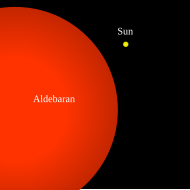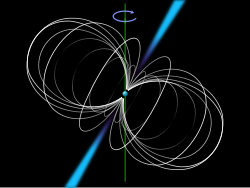Portal:Stars
IntroductionA star is a luminous spheroid of plasma held together by self-gravity. The nearest star to Earth is the Sun. Many other stars are visible to the naked eye at night; their immense distances from Earth make them appear as fixed points of light. The most prominent stars have been categorised into constellations and asterisms, and many of the brightest stars have proper names. Astronomers have assembled star catalogues that identify the known stars and provide standardized stellar designations. The observable universe contains an estimated 1022 to 1024 stars. Only about 4,000 of these stars are visible to the naked eye—all within the Milky Way galaxy. A star's life begins with the gravitational collapse of a gaseous nebula of material largely comprising hydrogen, helium, and trace heavier elements. Its total mass mainly determines its evolution and eventual fate. A star shines for most of its active life due to the thermonuclear fusion of hydrogen into helium in its core. This process releases energy that traverses the star's interior and radiates into outer space. At the end of a star's lifetime as a fusor, its core becomes a stellar remnant: a white dwarf, a neutron star, or—if it is sufficiently massive—a black hole. Stellar nucleosynthesis in stars or their remnants creates almost all naturally occurring chemical elements heavier than lithium. Stellar mass loss or supernova explosions return chemically enriched material to the interstellar medium. These elements are then recycled into new stars. Astronomers can determine stellar properties—including mass, age, metallicity (chemical composition), variability, distance, and motion through space—by carrying out observations of a star's apparent brightness, spectrum, and changes in its position in the sky over time. Stars can form orbital systems with other astronomical objects, as in planetary systems and star systems with two or more stars. When two such stars orbit closely, their gravitational interaction can significantly impact their evolution. Stars can form part of a much larger gravitationally bound structure, such as a star cluster or a galaxy. (Full article...) Selected star - Photo credit: commons:user:Riffsyphon1024 and commons:user:Mysid
Aldebaran (α Tau, α Tauri, Alpha Tauri) is a red giant star located about 65 light years away in the zodiac constellation of Taurus. With an average apparent magnitude of 0.87 it is the brightest star in the constellation and is one of the brightest stars in the nighttime sky. The name Aldebaran is Arabic (الدبران al-dabarān) and translates literally as "the follower", presumably because this bright star appears to follow the Pleiades, or "Seven Sisters" star cluster in the night sky. In 1997 a substellar companion was reported but subsequent observations have not confirmed this claim. Aldebaran is classified as a type K5III star. It is an orange giant star that has moved off the main sequence line of the Hertzsprung–Russell diagram. It has exhausted the hydrogen fuel in its core and hydrogen fusion has ceased there. Although not yet hot enough for fusing helium, the core temperature of the star has greatly increased due to gravitational pressure and the star has expanded to a diameter of 44.2 times the diameter of the Sun,Richichi & Roccatagliata (2005) derived an angular diameter of 20.58±0.03 milliarcsec, which given a distance of 65 light years yields a diameter of 61 million km.</ref> approximately 61 million kilometres (see 10 gigametres for similar sizes). The Hipparcos satellite has measured it as 65.1 light-years (20.0 pc) away, and it shines with 150 times the Sun's luminosity. Aldebaran is a slightly variable star, of the slow irregular variable type LB. It varies by about 0.2 in apparent magnitude. Selected article - Photo credit: User:Mysid and User:Jm smits
Pulsars are highly magnetized, rotating neutron stars that emit a beam of electromagnetic radiation. The observed periods of their pulses range from 1.4 milliseconds to 8.5 seconds. The radiation can only be observed when the beam of emission is pointing towards the Earth. This is called the lighthouse effect and gives rise to the pulsed nature that gives pulsars their name. Because neutron stars are very dense objects, the rotation period and thus the interval between observed pulses is very regular. For some pulsars, the regularity of pulsation is as precise as an atomic clock. A few pulsars are known to have planets orbiting them, such as PSR B1257+12. Werner Becker of the Max Planck Institute for Extraterrestrial Physics said in 2006, "The theory of how pulsars emit their radiation is still in its infancy, even after nearly forty years of work. The events leading to the formation of a pulsar begin when the core of a massive star is compressed during a supernova, which collapses into a neutron star. The neutron star retains most of its angular momentum, and since it has only a tiny fraction of its progenitor's radius (and therefore its moment of inertia is sharply reduced), it is formed with very high rotation speed. A beam of radiation is emitted along the magnetic axis of the pulsar, which spins along with the rotation of the neutron star. The magnetic axis of the pulsar determines the direction of the electromagnetic beam, with the magnetic axis not necessarily being the same as its rotational axis. This misalignment causes the beam to be seen once for every rotation of the neutron star, which leads to the "pulsed" nature of its appearance. The beam originates from the rotational energy of the neutron star, which generates an electrical field from the movement of the very strong magnetic field, resulting in the acceleration of protons and electrons on the star surface and the creation of an electromagnetic beam emanating from the poles of the magnetic field. This rotation slows down over time as electromagnetic power is emitted. When a pulsar's spin period slows down sufficiently, the radio pulsar mechanism is believed to turn off (the so-called "death line"). As this seems to take place after ~10-100 million years, but neutron stars have been formed throughout the ~13.6 billion year age of the universe, more than 99% of neutron stars are thought to no longer be pulsars. To date, the slowest observed pulsar has a period of 8 seconds. Selected image - Photo credit: commons:User:Pbroks13
An illustration of the structure of the Sun:
1. Core 2. Radiative zone 3. Convective zone 4. Photosphere 5. Chromosphere 6. Corona 7. Sunspot 8. Granules 9. Prominence Did you know?
SubcategoriesTo display all subcategories click on the ►
Selected biography - Photo credit: State Post Bureau of the People's Republic of China
Zhang Heng (simplified Chinese: 张衡; traditional Chinese: 張衡; pinyin: Zhāng Héng; Wade–Giles: Chang Heng) (CE 78–139) was a Chinese astronomer, mathematician, inventor, geographer, cartographer, artist, poet, statesman and literary scholar from Nanyang, Henan. He lived during the Eastern Han Dynasty (CE 25–220) of China. He was educated in the capital cities of Luoyang and Chang'an, and began his career as a minor civil servant in Nanyang. Eventually, he became Chief Astronomer, Prefect of the Majors for Official Carriages, and then Palace Attendant at the imperial court. His uncompromising stances on certain historical and calendrical issues led to Zhang being considered a controversial figure, which prevented him from becoming an official court historian. His political rivalry with the palace eunuchs during the reign of Emperor Shun (r. 125–144) led to his decision to retire from the central court to serve as an administrator of Hejian, in Hebei. He returned home to Nanyang for a short time, before being recalled to serve in the capital once more in 138. He died there a year later, in 139. Zhang applied his extensive knowledge of mechanics and gears in several of his inventions. He invented the world's first water-powered armillary sphere, to represent astronomical observation; improved the inflow water clock by adding another tank; and invented the world's first seismometer, which discerned the cardinal direction of an earthquake 500 km (310 mi) away. Furthermore, he improved previous Chinese calculations of the formula for pi. In addition to documenting about 2,500 stars in his extensive star catalogue, Zhang also posited theories about the Moon and its relationship to the Sun; specifically, he discussed the Moon's sphericity, its illumination by reflecting sunlight on one side and remaining dark on the other, and the nature of solar and lunar eclipses. His fu (rhapsody) and shi poetry were renowned and commented on by later Chinese writers. Zhang received many posthumous honors for his scholarship and ingenuity, and is considered a polymath by some scholars. Some modern scholars have also compared his work in astronomy to that of Ptolemy (CE 86–161).
TopicsThings to do
Related portalsAssociated WikimediaThe following Wikimedia Foundation sister projects provide more on this subject:
Discover Wikipedia using portals |

























